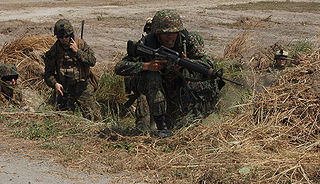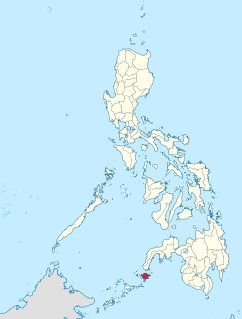Related Research Articles

Abu Sayyaf, officially known by the Islamic State as the Islamic State – East Asia Province, is a Jihadist militant and pirate group that follows the Wahhabi doctrine of Sunni Islam. It is based in and around Jolo and Basilan islands in the southwestern part of the Philippines, where for more than four decades, Moro groups have been engaged in an insurgency seeking to make Moro Province independent. The group is considered violent and was responsible for the Philippines' worst terrorist attack, the bombing of Superferry 14 in 2004, which killed 116 people. The name of the group is derived from the Arabic abu ; "father of"), and sayyaf. As of June 2021, the group is estimated to have less than 50 members, down from 1,250 in 2000. They use mostly improvised explosive devices, mortars and automatic rifles.
The 2002 Zamboanga bombings were a series of attacks perpetrated on the October 2, 17 and 21, 2002, around the southern Philippine port of Zamboanga City, Mindanao island. Eleven people died and over 180 others were wounded in the four bomb attacks allegedly perpetrated by Islamic extremists with connections to the Abu Sayyaf insurgent group.

Khadaffy Abubakar Janjalani was the leader of the Moro militant group known as Abu Sayyaf and the leader of one of its factions.
The Rizal Day bombings, also referred to as the December 30 bombings, were a series of bombings that occurred around Metro Manila in the Philippines on December 30, 2000. The explosions occurred within a span of a few hours. They caused 22 fatalities and around 100 non-fatal injuries.

Operation Enduring Freedom – Philippines (OEF-P) or Operation Freedom Eagle was part of Operation Enduring Freedom and the global War on Terror. The Operation targeted the various Jihadist terror groups operating in the country. By 2009, about 600 U.S. military personnel were advising and assisting the Armed Forces of the Philippines (AFP) in the Southern Philippines. In addition, by 2014, the CIA had sent its elite paramilitary officers from their Special Activities Division to hunt down and kill or capture key terrorist leaders. This group had the most success in combating and capturing Al-Qaeda leaders and the leaders of associated groups like Abu Sayyaf.
MV SuperFerry 14 was a Philippine registered roll-on/roll-off (ro-ro) ferry that was attacked on February 27, 2004, by a terrorist group Abu Sayyaf that resulted in the destruction of the ferry and the deaths of 116 people in the Philippines' deadliest terrorist attack. Six children less than five years old, and nine children between six and 16 years of age were among the dead or missing, including six students on a championship team sent by schools in northern Mindanao to compete in a journalism contest.
The Dos Palmas kidnappings was a hostage crisis in the southern Philippines that began with the seizing of twenty hostages from the affluent Dos Palmas Resort on a private island in the Honda Bay, Palawan, by members of Abu Sayyaf on May 27, 2001, and resulted in the deaths of at least five of the original hostages. Three of these hostages were American citizens, Guillermo Sobero, and a married missionary couple, Gracia and Martin Burnham. At least 22 Filipino soldiers were killed in attempts to apprehend the captors and free the hostages in the 12 months following the initial hostage taking. An unknown number of captors were killed by government forces.
2000 in the Philippines details events of note that happened in the Philippines in the year 2000.

Isnilon Totoni Hapilon, also known by the nom de guerreAbu Abdullah al-Filipini, was a Moro Filipino Islamist militant affiliated with ISIS. He was formerly leader of Abu Sayyaf Group, before its battalions pledged their allegiance to Abu Bakr al-Baghdadi. An April 2016 issue of ISIL's weekly newsletter Al Naba said that Hapilon had been appointed as "emir of all Islamic State forces in the Philippines".

Jainal Antel Sali Jr. was a senior leader of Abu Sayyaf, an Islamist terrorist organization affiliated with Al Qaeda.
The 2006 Central Mindanao bombings were a series of three bombings and one attempted bombing in Central Mindanao on October 10 and 11. Eight people were killed and between 30 and 46 were injured.
Terrorism is a major social issue in the Philippines and is linked to the Moro conflict and communist rebellion. The country ranks in 16th place on the Global Terrorism Index's 2022 list of countries most affected by terrorism.

The Mindanao bombings was a series of seemingly unrelated bomb attacks that took place on July 4, 5, and 7, 2009 in the towns of Datu Piang and Jolo, and the cities of Cotabato and Iligan in Mindanao, Philippines. The bombings killed around 7 people and injured at least 66. The Armed Forces of the Philippines has blamed several militant organizations active in Mindanao, such as the Moro Islamic Liberation Front (MILF), the Abu Sayyaf, and Jemaah Islamiyah.
2002 in the Philippines details events of note that happened in the Philippines in the year 2002.

The Battle of Tipo-Tipo was a military engagement that began on 9 April 2016 at Tipo-Tipo, Basilan Island, Philippines between forces of the Philippine Army and members of the Abu Sayyaf militant group. The battle resulted in dozens of casualties, with at least 18 soldiers and 31 militants reported killed, and more than 70 others injured. It was the largest single loss of life for the Philippine Army since the beginning of the year, and came just a day after the group had released an Italian hostage.
The following is a list of attacks which have been carried out by Abu Sayyaf, a militant group based in and around Jolo and Basilan islands in the southwestern part of the Philippines, where for more than four decades, Moro groups have been engaged in an insurgency for an independent province in the country.

A bombing at a night market occurred in Davao City, Philippines, on September 2, 2016, causing at least 14 deaths and 70 injuries. On September 13, 2016, one of those injured, a pregnant woman, died, bringing the death toll up to 15.
This is a chronology of the Moro conflict, an ongoing armed conflict in the southern Philippines between jihadist groups such as the Abu Sayyaf Group, the Maute Group, Jemaah Islamiyah, and Islamic State affiliates, mainstream separatist groups such as the Moro Islamic Liberation Front (MILF), the Moro National Liberation Front (MNLF) and the Bangsamoro Islamic Freedom Fighters (BIFF), and the Philippine Government since 1971. Much of the fighting has been concentrated on the island of Mindanao and the Sulu archipelago, with spillover incidents and attacks occurring in the Philippine capital Manila and neighboring countries such as Malaysia.
On July 31, 2018, a bomb exploded in the town of Lamitan in Basilan, Philippines.
The 2020 Jolo bombings occurred on August 24, 2020, when insurgents alleged to be jihadists from the Abu Sayyaf group detonated two bombs in Jolo, Sulu, Philippines, killing 14 people and wounding 75 others. The first occurred as Philippine Army personnel were assisting in carrying out COVID-19 humanitarian efforts. The second, a suicide bombing, was carried out near the Our Lady of Mount Carmel Cathedral.
References
- 1 2 "Philippines hit by three blasts". BBC News. 14 February 2005.
- 1 2 "Terror group claims 3 blasts in Philippines". NBC news. Associated Press. 14 February 2005.
- ↑ Rodel Clapano, Jose (9 March 2005). "Survivors, victims' kin file raps vs V-Day bombers". The Philippine Star .
- 1 2 Banlaoi, Rommel C. (13 May 2016). "Duterte's challenges: Terror, crime and the Abu Sayyaf". Rappler .
- 1 2 3 Gross, Max L. (2014) [March 2007]. A Muslim Archipelago: Islam and Politics in Southeast Asia. U.S. Department of Defense, Center for Strategic Intelligence Research, National Defense Intelligence College. p. 244. ISBN 9781932946192. Archived from the original on February 14, 2017.
- 1 2 Dacanay, Barbara Mae (10 March 2005). "Janjalani and six others charged for February 14 bombings". Gulf News .
- 1 2 Reformina, Ina (January 26, 2011). "SC affirms conviction of Abus for Valentine's Day bombing". ABS-CBN news . Retrieved February 12, 2017.
- 1 2 "3 people in Valentine's Day bombing case get life". GMA news. BusinessWorld. 10 July 2008.